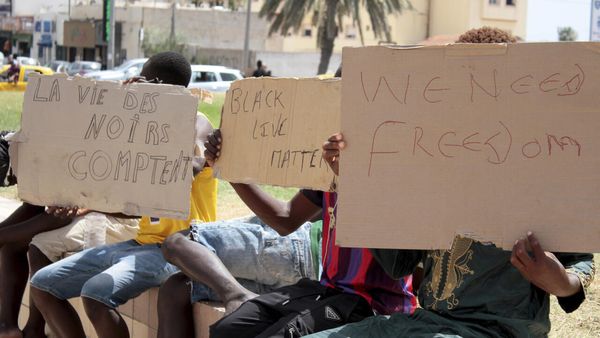
The viral video featuring Charli XCX and Billie Eilish is fun and all, but the two of them cavorting around in thousands of knickers and bras makes me feel uneasy. Visually, it feels indicative of our collective attitude to clothing as something disposable, and its eventual end-cycle dumped in rivers and beaches around the global south.
In the video, the lingerie is shown piled up and heaved around by Eilish’s pick-up truck, with pieces blasted around in the air as if a helicopter had just landed in a branch of Victoria’s Secret, spewing lingerie into the sky. There is a disclaimer at the end of the video: “Unworn undergarments to be donated to survivors of domestic violence through I Support The Girls” — an American period poverty charity. Which is fine, I guess. But is it? Couldn’t they have donated to the cause without flinging the garments around the studio-lot pavement and driving over them with giant tyres? It feels like a cynical easy win to stave off any negative reactions to the wastage created by the video.
The shop, churn and chuck away cycle is part of a culture that says consuming clothing endlessly is fine because, hey, we can just dump it in the doorway of a charity shop, or next to a recycling bin (why never inside?). We think that as long as we pass an item on, we can carry on accumulating. “One in one out” is the cry of many fashion editors pulling together a “how to organise your wardrobe” feature, or indeed to justify new purchases. That the secondhand clothing market is on course to be bigger than the “fast fashion” market isn’t a victory, it’s a sign of over-production and hyper-consumption, a reflection of the endless accumulation of stuff we don’t need.
To my mind, if you buy something, you are responsible for it; and as we know from the suffocating amounts of clothing from high street retailers lining Ghana’s beaches, there is no getting rid of anything. In chucking things “away” we’re simply making it someone else’s problem.
At Kantamanto market in the Ghanaian capital Accra, one of the world’s biggest sellers of secondhand clothing, the mounds of our binned fashion items are referred to as obroni wawu: “dead white man’s clothes”.
The journalist Fleur Britten recently shared footage of her family holiday to Ghana, where she and her children took part in clean-up operations on the beaches with the Or Foundation, a non-profit which campaigns and runs recycling initiatives. Among the extraordinary, apocalyptic piles of discarded stuff were pieces from Nike, adidas, Tu at Sainsbury’s, M&S, Next and even Paul Smith. Dealing with our dead waste is a full-time endeavour.
The barely regulated fashion industry happily avoids taking responsibility for its wanton overproduction, or the fact that it is one of the biggest global polluters.
Livia Firth elevated the issues of the industry by playing to its vanity and ego
There are huge amounts of work being done by sustainable think tanks and activist organisations in the sector, but it can feel depressingly as if they are shouting into the wind — see our courting of Shein’s proposed London stock market listing.
A new report from Fashion Revolution documents the dismal and green-washed approach to carbon emissions in the unruly and opaque supply chain system that creates our clothes. The What Fuels Fashion report surveyed 250 brands and found that: “The fashion industry is lagging significantly in achieving climate targets and reducing emissions, with 86 per cent of companies lacking a public coal phase-out target, 94 per cent without a public renewable energy target, and 92 per cent without a public renewable electricity target for their supply chains. Less than half (43 per cent) of brands are transparent about their energy procurement at the operational level, and even fewer (10 per cent) at supply chain level. Additionally, no major fashion brand discloses hourly matched supply chain electricity use. As a result, big fashion’s zero-emissions claims may be disconnected from grid realities, creating a false sense of progress against climate targets.”
In response, Fashion Revolution is asking for brands to invest two per cent of revenue into driving a renewable and just transition through their supply chains — aiming to avoid the onus being on poorly paid producers having to navigate this issue themselves.
Sustainability conundrums have never been sexy. One woman who tried to elevate the status of sustainability was Livia Firth, who — via her Eco-Age agency — launched the Green Carpet Fashion Challenge and a glitzy LA awards ceremony, which at least harnessed some celebrity power for the cause. Firth announced last week that she had been forced to close her agency because it had been “targeted by criminals” and it was unable to recover financially. One thing Firth did was to elevate the issues of the industry by playing to its vanity and ego — here are some starry celebrities looking fabulous, and also this dress is recycled. It was a clever way of putting those thoughts into a glamorous backdrop. Without her, we’re left with the mountains of stuff, a wilful approach at concealment by major brands and some pop stars dancing around on mounds of knickers. Where next, who knows.







